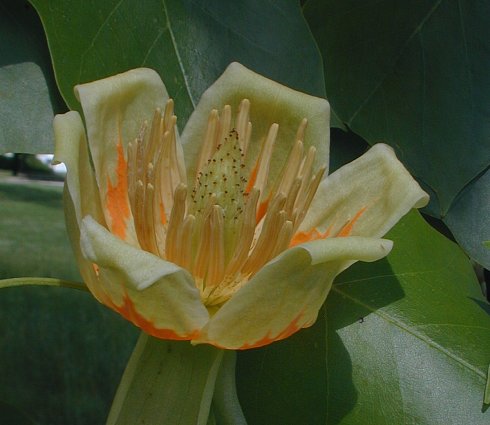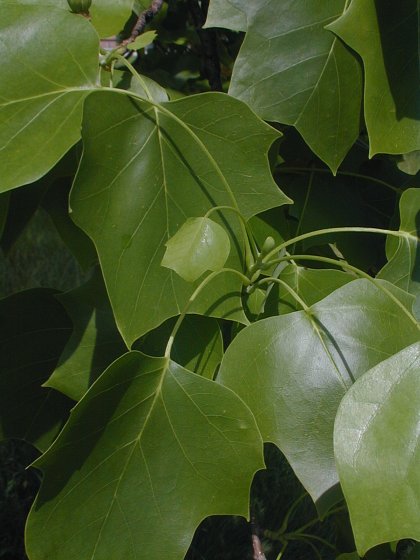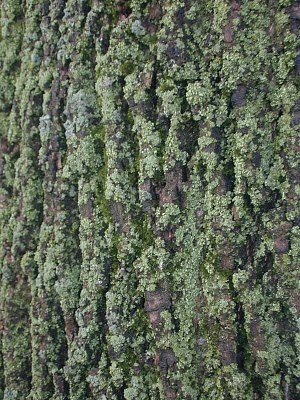Description: At maturity, this tree becomes 80-120' tall. It has a long straight trunk up to 3' in diameter. Young trees that are grown in the open often have a pyramidal crown, but the crown of mature trees is more ovoid-oblongoid in shape. The bark of the trunk is light gray to gray with whitish furrows; sometimes it is covered with lichens. The bark of branches is light gray and nearly smooth. Young twigs are usually yellowish to reddish brown and shiny; the leaves along these twigs are alternate. The leaf blades are about 4-7" long and 4-7" across. Each blade has 1-2 pairs of broad basal lobes with pointed tips, a pair of broad terminal lobes with pointed tips, and smooth margins. Leaf veins are pinnate. The upper surface of each blade is shiny green or shiny dark green, while the lower surface is pale green; both surfaces are hairless. The slender leaf petioles are 2-6" long, light green, and hairless. At the base of each petiole, there is a pair of deciduous stipules about 1½" long.

Individual
flowers develop from the axils of the leaves on short stalks. Each
tulip-shaped flower is about 2-3" across and 2½" long; it has 6
upturned petals and 3 sepals that hang downward. The thick waxy petals
are oval-oblong in shape and yellowish green (rarely white); each petal
has a patch of bright orange toward its base. The sepals are slightly
shorter and more narrow than the petals; they are pale green to nearly
white. In the center of each flower, there is a cone-shaped cluster of
narrow pistils about 2½" long, which is surrounded by numerous stamens.
The blooming period occurs during late spring and lasts about 3 weeks.
The flowers are slightly fragrant. The pistils become transformed into
a dense cluster of brown samaras. Each narrow samara is about 1½" long,
consisting of 1 seed (rarely 2) at the bottom, and a long membranous
wing above. The samaras detach from the underlying receptacle
individually; they can be blown about by the wind, sometimes at a
distance that is 3-5 times the length of the tree. The root system is
woody and branching with a poorly developed taproot. This tree
reproduces by reseeding itself.
Cultivation:
Tulip
Tree prefers to be grown in full or partial sun, mesic conditions, and
fertile soil that is loamy or silty. It develops fairly rapidly for a
tree and can produce flowers in less than 10 years.

Range & Habitat: Tulip
Tree is native to southern and southeastern Illinois, where it is
occasional (see Distribution
Map). However, it has been introduced to natural areas in
other parts of the state, where it is uncommon. Because of its
ornamental flowers and foliage, Tulip Tree is often grown in lawns and
parks. In natural areas, habitats include mesic woodlands, lower areas
of wooded slopes, and protected wooded valleys. Tulip Tree is
intermediate in the succession of vegetation; it grows quickly to
out-compete pioneer shrubs and smaller trees, but its saplings are less
tolerant of shade than the saplings of Acer saccharum
(Sugar Maple), Tilia americana (American Basswood),
and Fagus grandifolia (American Beech), which
ultimately replace it in an undisturbed forest.
Faunal Associations:
The nectar and pollen of the flowers attract miscellaneous flies,
beetles, honeybees, bumblebees, and other long-tongued bees. The
Ruby-Throated Hummingbird also visits the flowers for nectar. Some
insects feed on the foliage, sap, or wood of Tulip Tree. These species
include Toumeyella liriodendri (Tulip Tree Scale), Illinoia
liriodendri (Tulip Tree Aphid), Odontopus calceatus
(Yellow Poplar Weevil), Euzophera ostricolorella
(Root-Collar Borer Moth), Callosamia angulifera
(Tulip Tree Moth), Callosamia promethea (Promethea
Moth), the moth Epimecis hortaria (Tulip Tree
Beauty), and the butterfly Papilio glaucus (Tiger
Swallowtail). Some vertebrate animals use this tree as a source of
food. The seeds are eaten by such birds as the Cardinal, Goldfinch,
Carolina Chickadee, and Purple Finch. The Fox Squirrel, Gray Squirrel,
Red Squirrel, White-Footed Mouse, and Woodland Deer Mouse also eat the
seeds. White-Tailed Deer browse on the twigs and foliage, as do horses,
cattle, and other kinds of livestock. The Yellow-Bellied Sapsucker
often drills holes through the bark of this tree to obtain the sap; the
Ruby-Throated Hummingbird sometimes obtains sap from these holes as
well. These birds also consume insects that become trapped in this sap.
The Pileated Woodpecker sometimes uses this tall tree as a nest site.

Photographic
Location:
A city park in Urbana, Illinois.
Comments:
This is a beautiful and majestic tree. There is no other tree in
Illinois that is similar to it. Because of its long straight trunks,
Amerindians were able to make an entire canoe from a single log of this
tree. Other common names of Liriodendron tulipifera
are Yellow Poplar and Tulip Poplar.